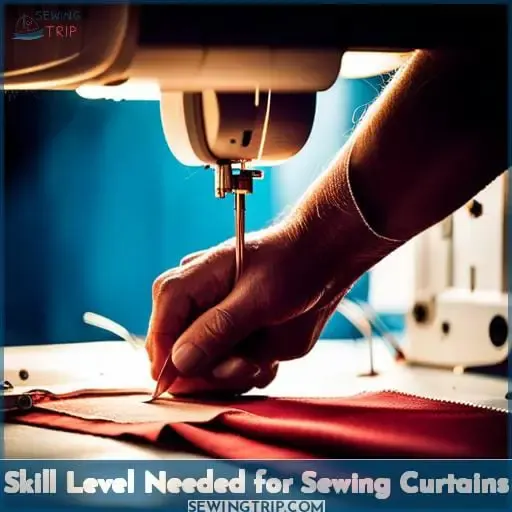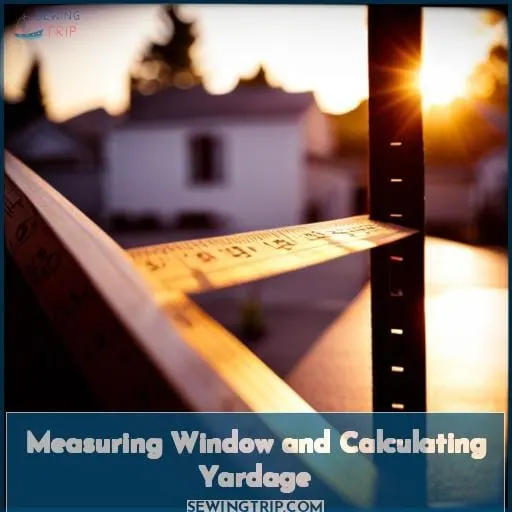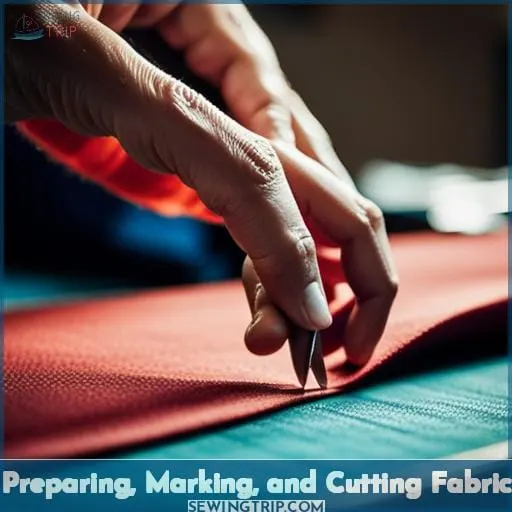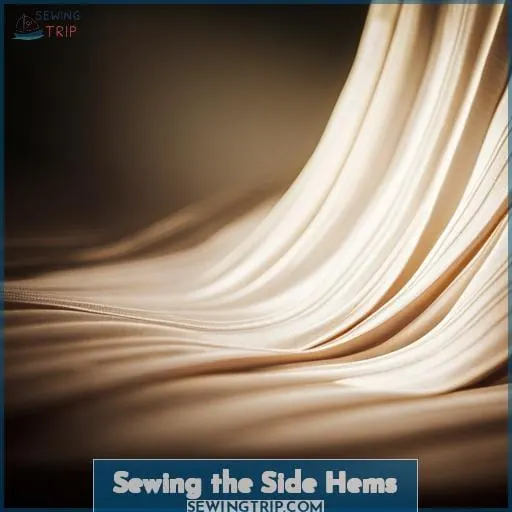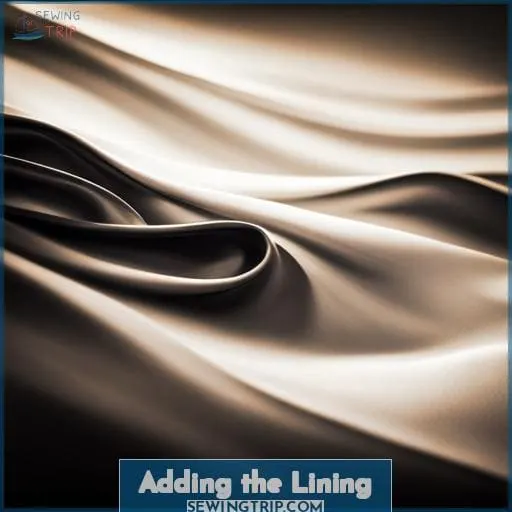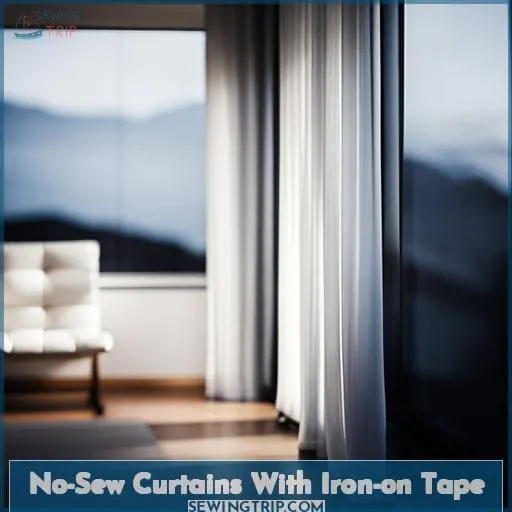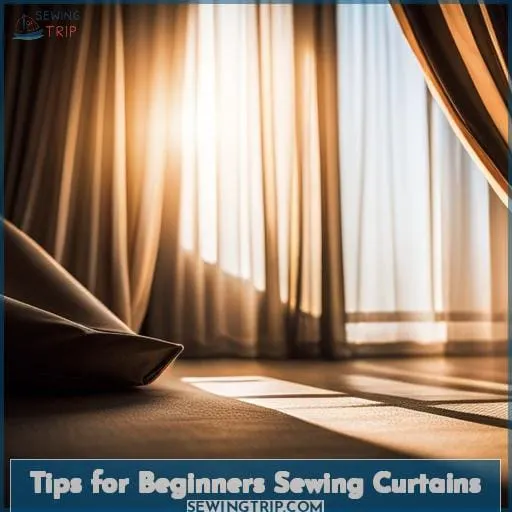This site is supported by our readers. We may earn a commission, at no cost to you, if you purchase through links.
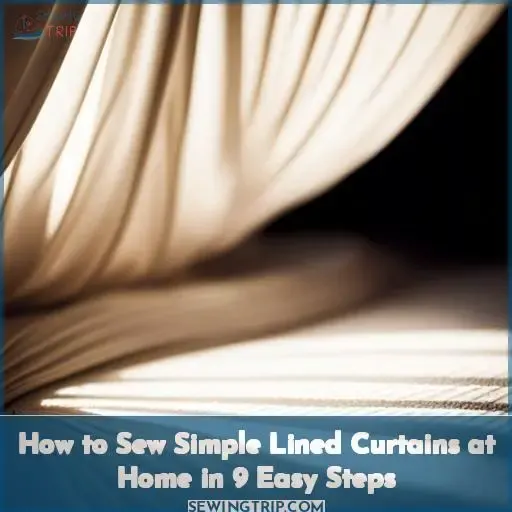 Like a butterfly emerging from its cocoon, making your own curtains allows you to transform the look and feel of a room.
Like a butterfly emerging from its cocoon, making your own curtains allows you to transform the look and feel of a room.
With just basic sewing skills and supplies, you can create custom, lined drapes at home for a fraction of the store-bought cost.
This step-by-step guide will walk you through sewing simple yet elegant curtains in 9 easy steps.
From measuring to cutting fabric to adding pleats, you’ll gain the freedom to decorate on your budget.
Table Of Contents
- Key Takeaways
- Is It Cheaper to Make Your Own Curtains?
- Skill Level Needed for Sewing Curtains
- Materials You’ll Need for DIY Curtains
- Measuring Window and Calculating Yardage
- Preparing, Marking, and Cutting Fabric
- Sewing the Side Hems
- Adding the Lining
- Hanging Your New Curtains
- No-Sew Curtains With Iron-on Tape
- Tips for Beginners Sewing Curtains
- Frequently Asked Questions (FAQs)
- Conclusion
Key Takeaways
- Measure window width and desired finished length carefully for accurate fabric yardage needs
- Focus on keeping fabric grain straight when cutting and seams straight when sewing
- Finish side hems before joining fashion fabric to lining
- Allow for proper fullness and gathering at top for smooth hanging
Is It Cheaper to Make Your Own Curtains?

You’ll save a bundle by sewing your own lined curtains rather than buying ready-made.
Purchasing retail curtains can be quite pricey, especially for custom sizes. Making your own allows you to buy affordable fabric and turn it into beautiful, tailored window treatments.
With some basic sewing skills, you can create lined curtains for a fraction of the store-bought cost.
Choosing your own fabrics also provides limitless options for colors, patterns, and textures.
Sewing curtains yourself gives great satisfaction and allows creativity. It’s an eco-friendly option too since you can use fabrics sustainably.
Overall, sewing your own lined curtains will save you money compared to retail while letting you customize to your style.
Skill Level Needed for Sewing Curtains
Your level of sewing experience determines the type of DIY curtain project that’s achievable.
Even if you’ve never touched a sewing machine, simple lined curtains are doable.
Start with a basic straight stitch and focus on keeping your seams straight.
Invest time in properly measuring and cutting your fabric.
For your first sewing project, choose a medium weight cotton in a solid print.
This will be easier to work with than a slippery satin or delicate sheer.
There are also no-sew DIY curtain options using iron-on bonding tape or clipped curtain rings.
With the right preparation and materials, sewing your own curtains can give you custom window dressings while saving money.
Incorporate small challenges as you gain skills.
Soon you’ll have the confidence to tackle more complex projects.
The DIY approach allows creative freedom at a fraction of retail cost.
Materials You’ll Need for DIY Curtains
To begin your DIY curtain project, you’ll need:
- Drapery and lining fabrics
- Threads
- Pins
- Measuring tools
- Iron
- Sewing machine
You should also gather:
- Curtain rings
- Hooks
- Pleater tape
- Other notions required for your desired curtain style
With the right fabrics, tools, and notions on hand, you’ll be ready to sew cute custom curtains in no time.
Fabric
Transitioning from skill level, you’ll next need to select an appropriate fabric for the curtains.
- Heavy weight cotton or cotton-linen blend works well.
- Purchase enough yardage for your desired length and width.
- Consider the fabric’s pattern and if it complements your space.
For no-sew curtains, use iron-on bonding tape to join pieces.
Notions
Screw eyes and pleater tape are essential notions for DIY curtains.
Choose clips and hooks to match your desired style.
Pleater tape eliminates gathering and keeps panels uniform.
Interfacing adds body and drape to fabric.
For no-sew curtains, bond fabrics with Heat n’ Bond.
Match drapery weight to clip strength.
Notions tailor the look while simplifying sewing.
Tools
All the tools you’ll need are:
- A hard ruler or square
- Measuring tape
- Fabric scissors
- Iron
- Ironing board
- Stick pins
- Sewing machine
Before starting your DIY curtain project, gather these essential tools.
Have your ironing board set up with a quality iron to press seams and hems.
Locate your fabric scissors, measuring tape, straight edge, and pins.
Borrow or obtain access to a sewing machine suited for basic straight line stitching.
Refer to online video tutorials for guidance as you cut and sew custom curtains perfectly fitted to your windows.
Achieve the desired pooling and elegant drape with careful measurements and hem lengths.
Measuring Window and Calculating Yardage
You’ll need to measure the window width and desired finished length for each panel to determine the amount of fabric yardage required.
Measure across the top, middle, and bottom of the window for width, recording the largest measurement.
For length, decide your ideal drape drop from top of rod to floor or window sill.
Calculate the number of fabric widths needed to cover window width based on standard 54-inch widths.
Plan repeats and placement of bold patterns.
Get 20% extra yardage for matching designs and mistakes.
Consider a budget-friendly solid or subtly patterned fabric.
Mount the rod 6+ inches above the window frame so drapes can stack attractively when opened.
Precision planning prevents purchasing pitfalls and yields successful homemade draperies.
With mindful calculations, sewing lined curtains is achievable for sewers at every skill level.
Preparing, Marking, and Cutting Fabric
How do you prepare the fabric once you’ve calculated the yardage?
Carefully unroll and spread out the fabric, ensuring it lies smooth and square on the cutting surface.
Remove all folds and wrinkles by gently pulling the fabric taut.
Run an iron set to the fabric type over the entire surface to relax fibers and achieve a flat working area.
Align one selvage edge, if present, parallel to the table’s side.
Smooth remaining sections flat, gently stretching crosswise grain straight.
Pin down edges temporarily if needed.
Mark cutting lines the finished curtain length plus desired hem allowances using a yardstick and fabric marker.
Use a large clear gridded cutting mat to keep lines square.
Cut through all layers decisively with sharp dressmaking shears.
Take care to not stretch or misalign fabric.
Periodically check grain and pattern alignment, making adjustments as you work.
Press seams open, then finished side down.
Careful preparation now allows efficient progress sewing precise curtains.
Sewing the Side Hems
You sew the side hems by folding each side of the panel in 3 inches from top to bottom, including the hem, pressing, folding in half again, pressing, and pinning or clipping into place.
Align the pattern precisely before folding and pressing to ensure even exposure on the front side.
Use the tip of your iron and gentle pressure while pressing to avoid imprinting the fabric.
Take care not to stretch the fabric out of shape.
Stitch the side hems using a blind hem stitch, catching just a thread or two of the main fabric on the front side.
This creates an invisible hem that maintains the drape beautifully.
Or use a straight stitch about 1⁄4 inch from the inner folded edge for a discreet but visible hem.
Choose a thread color that matches or blends into your fabric.
Hemming tricks like clipping or pinning make sewing side hems on lined curtains easier.
Adding the Lining
Next, we’ll go over adding the lining to your curtains.
Join the front panel to the lining, making sure the tops are aligned.
Sew together with a 1-inch seam allowance.
Open, press, and finish the side hems.
Cutting
The lining panel needs measuring and cutting 1 inch shorter than the finished length of the drapery panel before hemming it with a 3-inch double fold.
When preparing the lining fabric, first remove any selvage edges and use an iron to smooth out wrinkles.
Then, carefully measure and square the fabric on your work surface before cutting it precisely 1 inch less than the finished drapery length.
Fold the raw bottom edge up 6 inches and press.
Then fold this hem up 3 inches to create a neat 3-inch double hem along the bottom.
Hemming
After cutting the lining fabric to size, double hem it by:
- Folding up the raw edge 6 inches
- Sewing a 3-inch double hem with a regular straight stitch
Align the hemmed lining panel right sides together with the main curtain panel.
Pin the layers together along the top edge.
Sew the panels together using a 1-inch seam allowance.
Press the joined seam open, then flip and press closed.
This encloses the raw edges while allowing the curtains to hang smoothly.
For no-sew curtains, iron-on bonding tape joins the layers.
Joining
With your fabric and lining now hemmed, it’s time to join the layers.
Lay the finished fronts right sides together and pin.
Carefully align the raw edges at the top and sides before sewing together with a 1-inch seam allowance.
Finish by pressing the seams open, then flip and press closed.
This encases the raw edges and joins the lining to the drapery panel in a clean, professional manner suitable for hanging.
Consider adding pleats or opting for no-sew tape when attaching curtains for quicker DIY alternatives.
Hanging Your New Curtains
You simply slide your finished curtain panels onto the curtain rods or hooks to hang your new lined curtains.
Measure the width of each window and cut your curtain rod to size.
Account for any decorative finials on the ends.
Position the curtain rod 6-8 inches above the window frame and at least 3 inches wider than the window itself.
This allows the curtains to stack attractively when opened.
Screw curtain rod brackets into the wall, centering over each window.
Slide on the curtain rod.
Carefully arrange the pleats or gathers on each panel and clip curtain rings every 6-8 inches along the top.
Slide rings onto the rod, spacing panels evenly across the window.
Ensure pattern alignment matches on adjoining panels.
Enjoy the natural light filtering through your new DIY curtains!
Consider no-sew clip-on curtain options for temporary blackout abilities or future easy laundering.
No-Sew Curtains With Iron-on Tape
Frequently, you’re using Heat ‘n Bond tape for joining fabric pieces without sewing to create no-sew curtains.
This iron-on adhesive tape bonds fabrics together to form curtain panels.
Lay your fabric pieces out in order, then place the tape over the seams following package directions.
Use an iron set to cotton or linen to bond the pieces.
| Temperature | Time | Pressure |
|---|---|---|
| Cotton | 2-5 seconds per inch | Firm |
| Linen | 3-7 seconds per inch | Firm |
| Wool | 1-3 seconds per inch | Light |
After ironing and allowing to cool, give the tape gentle tugs to ensure a strong bond before hanging.
For best results, add an interfacing backing to help stiffen.
Consider neutral colors like canvas, ticking stripe, burlap, or lightweight linens for iron-on tape projects.
This no-sew technique saves time and allows even novices to DIY quick, casual curtains or valances using clever iron-on bonding.
Tips for Beginners Sewing Curtains
When trying your hand at sewing curtains for the first time, start with basic straight seams and add details slowly as skills advance.
- Focus on fabric selection first: medium to heavy-weight cottons or blends work best.
- Before cutting, learn techniques for measuring windows, calculating yardage, and marking/cutting fabric straight.
- Simple side hems and a generous bottom hem allow ample room for mistakes. Leave extra length for adjustments.
- Try no-sew heat bond tapes to join panels before sewing. This allows you to preview finished panels.
- Carefully pin patterns and use clips with blackout lining to prevent shifting during construction.
- Enlist a seasoned sewer’s guidance. In-person coaching can clarify techniques that YouTube leaves unclear.
Frequently Asked Questions (FAQs)
What kind of thread should I use?
Use polyester thread for sewing drapes.
This all-purpose thread works well with most fabrics and holds up better than cotton over time.
Go for a neutral color like white or tan to blend in.
Match the thread closely to your fabric color if possible for an invisible look from the front.
Polyester thread will give you the durability you need.
How do I make pleated curtains?
- Start by cutting your fabric double the width of the window and attach it to pleater tape.
- Then simply pull the tape to create even pleats, pinning it into place.
- Finally, hand-stitch the top of the pleater to curtain rings and evenly space them across your curtain rod for the finished look.
What’s the best way to clean drapes I’ve sewn?
To keep your sewn drapes spick and span:
- Gently vacuum them with a soft brush attachment.
- Toss them in the wash on a delicate cycle with cold water and mild detergent.
Hang them to dry, and they’ll be ready to grace your windows once more.
Can I use a sewing machine for curtains if I’m a beginner?
Yes, a sewing machine is perfectly suitable for a beginner making curtains.
Focus on straight lines first.
Use cotton fabric and polyester thread.
Watch online video tutorials.
Go slowly and don’t worry about mistakes – relaxing will help you learn.
Ask a friend for tips if you get stuck.
What length should my curtains be for floor-to-ceiling windows?
To cover floor-to-ceiling windows, make your curtain panels 8 inches above the actual floor height.
This extra length will beautifully frame the windows while allowing the fabric to puddle attractively on the floor, flowing gracefully to the floor like a waterfall cascading gently over rocks.
Conclusion
By heeding this guide’s advice, you’ll transform lifeless windows into frames of elegance.
We investigated sewing’s cost-effectiveness so you can budget wisely when making drapes at home.
With some dedication and these key steps on how to sew drapes, you’ll soon admire custom curtains accenting your space beautifully.
Experiment with fabrics and have fun decorating while adding cozy style with handmade lined drapes that suit your unique taste.

